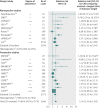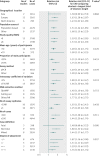Leucocyte telomere length and risk of cardiovascular disease: systematic review and meta-analysis
- PMID: 25006006
- PMCID: PMC4086028
- DOI: 10.1136/bmj.g4227
Leucocyte telomere length and risk of cardiovascular disease: systematic review and meta-analysis
Abstract
Objective: To assess the association between leucocyte telomere length and risk of cardiovascular disease.
Design: Systematic review and meta-analysis.
Data sources: Studies published up to March 2014 identified through searches of Medline, Web of Science, and Embase.
Eligibility criteria: Prospective and retrospective studies that reported on associations between leucocyte telomere length and coronary heart disease (defined as non-fatal myocardial infarction, coronary heart disease death, or coronary revascularisation) or cerebrovascular disease (defined as non-fatal stroke or death from cerebrovascular disease) and were broadly representative of general populations--that is, they did not select cohort or control participants on the basis of pre-existing cardiovascular disease or diabetes.
Results: Twenty four studies involving 43,725 participants and 8400 patients with cardiovascular disease (5566 with coronary heart disease and 2834 with cerebrovascular disease) were found to be eligible. In a comparison of the shortest versus longest third of leucocyte telomere length, the pooled relative risk for coronary heart disease was 1.54 (95% confidence interval 1.30 to 1.83) in all studies, 1.40 (1.15 to 1.70) in prospective studies, and 1.80 (1.32 to 2.44) in retrospective studies. Heterogeneity between studies was moderate (I(2) = 64%, 41% to 77%, Phet<0.001) and was not significantly explained by mean age of participants (P = 0.23), the proportion of male participants (P = 0.45), or distinction between retrospective versus prospective studies (P = 0.32). Findings for coronary heart disease were similar in meta-analyses restricted to studies that adjusted for conventional vascular risk factors (relative risk 1.42, 95% confidence interval 1.17 to 1.73); studies with ≥ 200 cases (1.44, 1.20 to 1.74); studies with a high quality score (1.53, 1.22 to 1.92); and in analyses that corrected for publication bias (1.34, 1.12 to 1.60). The pooled relative risk for cerebrovascular disease was 1.42 (1.11 to 1.81), with no significant heterogeneity between studies (I(2) = 41%, 0% to 72%, Phet = 0.08). Shorter telomeres were not significantly associated with cerebrovascular disease risk in prospective studies (1.14, 0.85 to 1.54) or in studies with a high quality score (1.21, 0.83 to 1.76).
Conclusion: Available observational data show an inverse association between leucocyte telomere length and risk of coronary heart disease independent of conventional vascular risk factors. The association with cerebrovascular disease is less certain.
© Haycock et al 2014.
Conflict of interest statement
Competing interests: All authors have completed the Unified Competing Interest form at
Figures



Comment in
-
Telomere length predicts cardiovascular disease.BMJ. 2014 Jul 8;349:g4373. doi: 10.1136/bmj.g4373. BMJ. 2014. PMID: 25005709 No abstract available.
References
-
- Balasubramanyam M, Adaikalakoteswari A, Monickaraj SF, Mohan V. Telomere shortening and metabolic/vascular diseases. Indian J Med Res 2007;125:441-50. - PubMed
-
- Samani NJ, van der Harst P. Biological ageing and cardiovascular disease. Heart 2008;94:537-9. - PubMed
-
- Mather KA, Jorm AF, Parslow RA, Christensen H. Is telomere length a biomarker of aging? A review. J Gerontol A Biol Sci Med Sci 2011;66:202-13. - PubMed
-
- Takubo K, Izumiyama-Shimomura N. Telomere lengths are characteristic in each human individual. Exp Gerontol 2002;37:523-31. - PubMed
Publication types
MeSH terms
Grants and funding
LinkOut - more resources
Full Text Sources
Other Literature Sources
